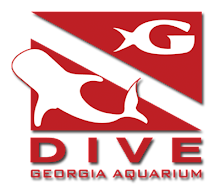What a way to start 2011! Just before midnight on New Year’s Eve, a significant leak developed in an outlet pipe of Ocean Voyager. The leak’s placement was such that it could not be isolated using only valves, so Dive Ops was called in to install a flange plate onto the end of a 54” pipe.
Through coordinated efforts of Dive Operations, Life Support Systems, Ocean Voyager Husbandry, and Audio/Visual, after 12 hours of activity including nearly 6 hours of diving, the leak was successfully isolated.
Here’s what took place:
Dive Ops arrived on the morning on January 1st, approximately 9am and began staging equipment. LSS used a forklift to remove the decking structure over the OV sump, to allow easy access to the 40 ft deep tank where we would be working. They also staged the flange plate, two locking collars, and about 50 large securing bolts. While that was going on, Dive Ops began staging surface supply umbilicals, helmets, lift bags, air compressors, and air and hand tools. A/V set up a monitor and interface box connected to a camera on one of our helmets, so topside could see how the procedure was progressing. Once staged, Dive Ops and LSS conferenced called with the DSO, who was out of town at the time.
Once everything was ready, Elliott Jessup, Jim McAlister, and Adam Harrison donned surface supply gear and entered the OV sump. They positioned at various depths in the sump and then LSS lowered the 3500 lb flange plate and 600 lb locking collars to the bottom of the sump. Lift bags were then used to assist in positioning of those very heavy objects around the open end of the 54” pipe.
While the collars and plate were being positioned, topside lowered the securing bolts and hand tools using a rope/bucket system.
Once the collars and flange plate were positioned, the divers began securing them to each other with the bolts, sandwiching the flanged end of the pipe between the collars and the plate.
After nearly 3 ½ hours at depth and approaching no-decompression limits, it was decided terminate the dive, have a surface interval, and then come back to complete the job. The divers were in for quite a surprise upon surfacing! A crowd of curious onlookers from all departments of the aquarium had gathered to compliment and encourage them, for there was much yet to be done. And what more, an impressive spread of sandwiches, chips, coffee, water, and cookies had been brought up! The next hour was spent replenishing energy, hydrating, decompressing, warming up, and discussing the events of the day.
Once the dive computers showed enough offgassing had occured, Jim McAlister and Adam Harrison reentered the sump, this time joined by Chris Schrieber from OV Husbandry. Using a combination of large wrenches, socket wrenches, an air drill, and good old fashioned elbow grease, they spent over two hours completing the seal over the pipe.
The divers exited the sump exhausted, but in high spirits. Situations like this don’t come up very often, but when they do, Dive Ops has a chance to really shine.
Subscribe to:
Post Comments (Atom)



Wow. That is an amazing story. Don't think I would be able to keep my cool underwater at all. Though I suppose if there was one tool to get the job done it would be a socket wrenches . I use a socket wrenches for everything. I am glad that they were able to fix the leak with out any dangerous consequences.
ReplyDelete